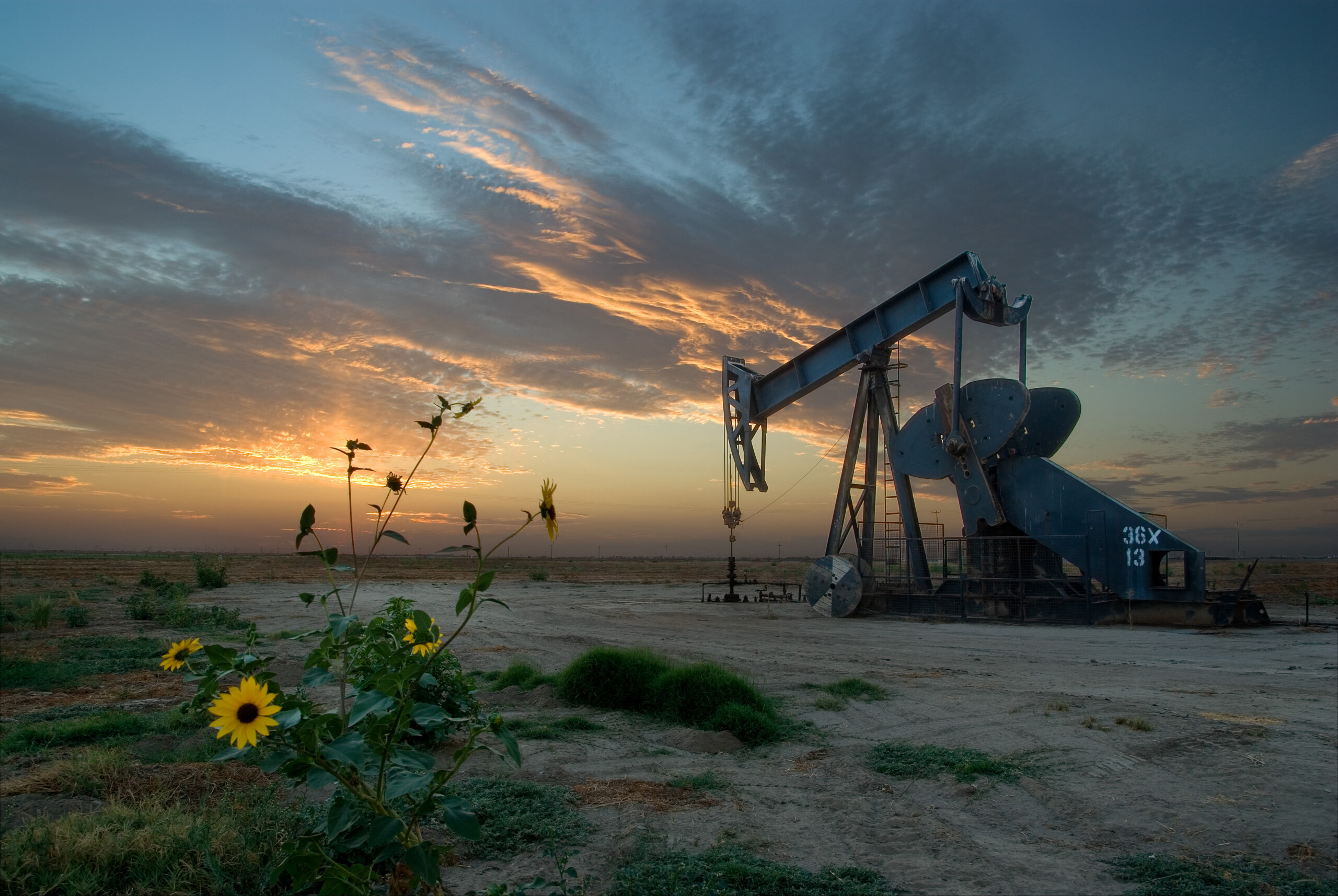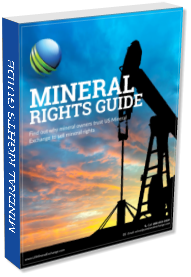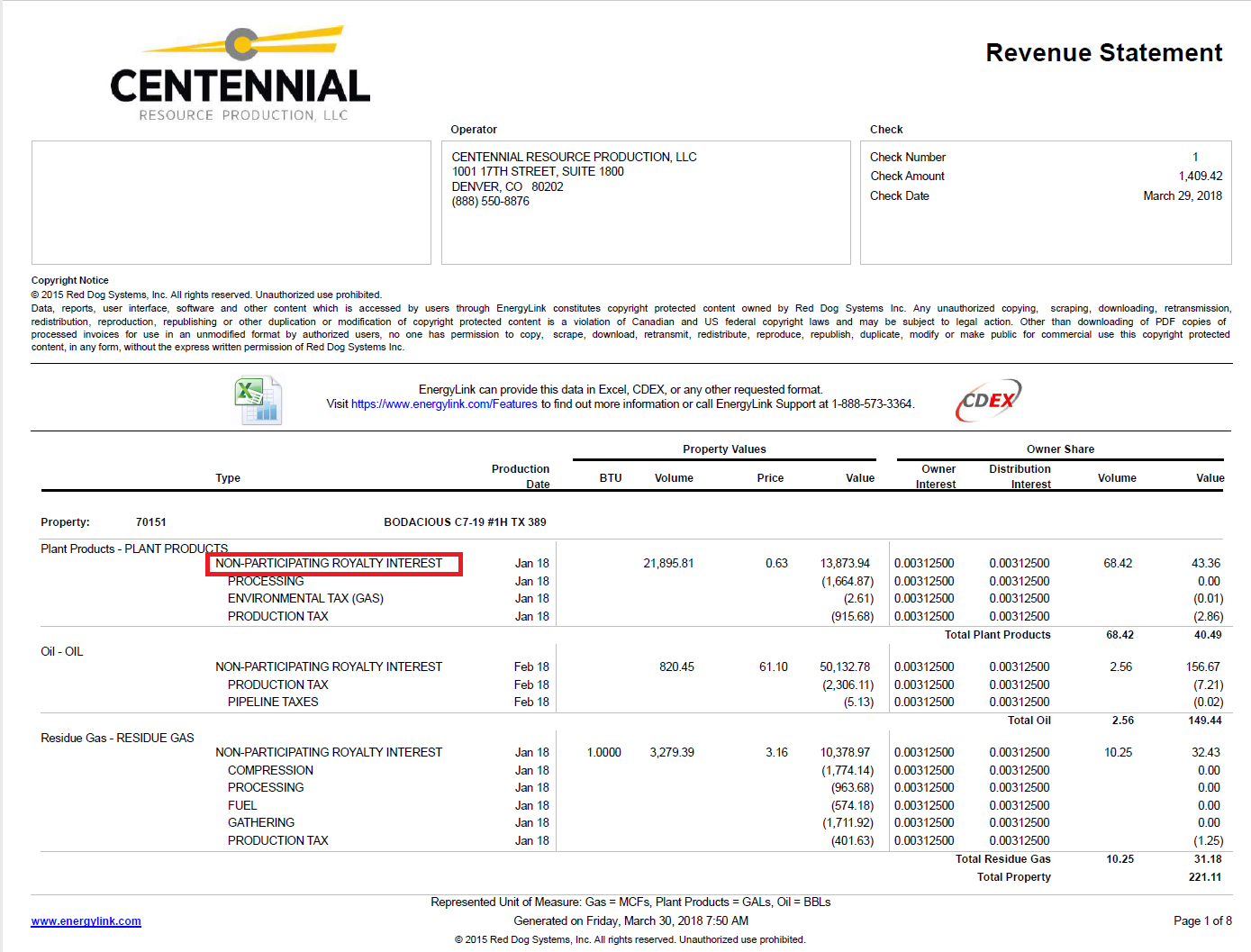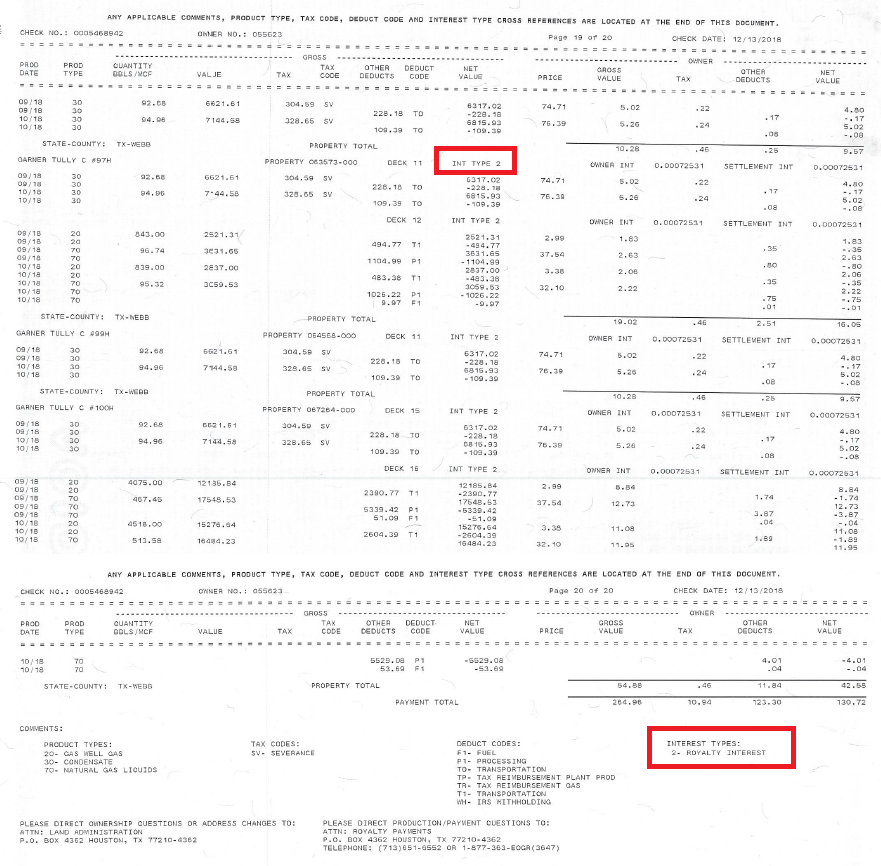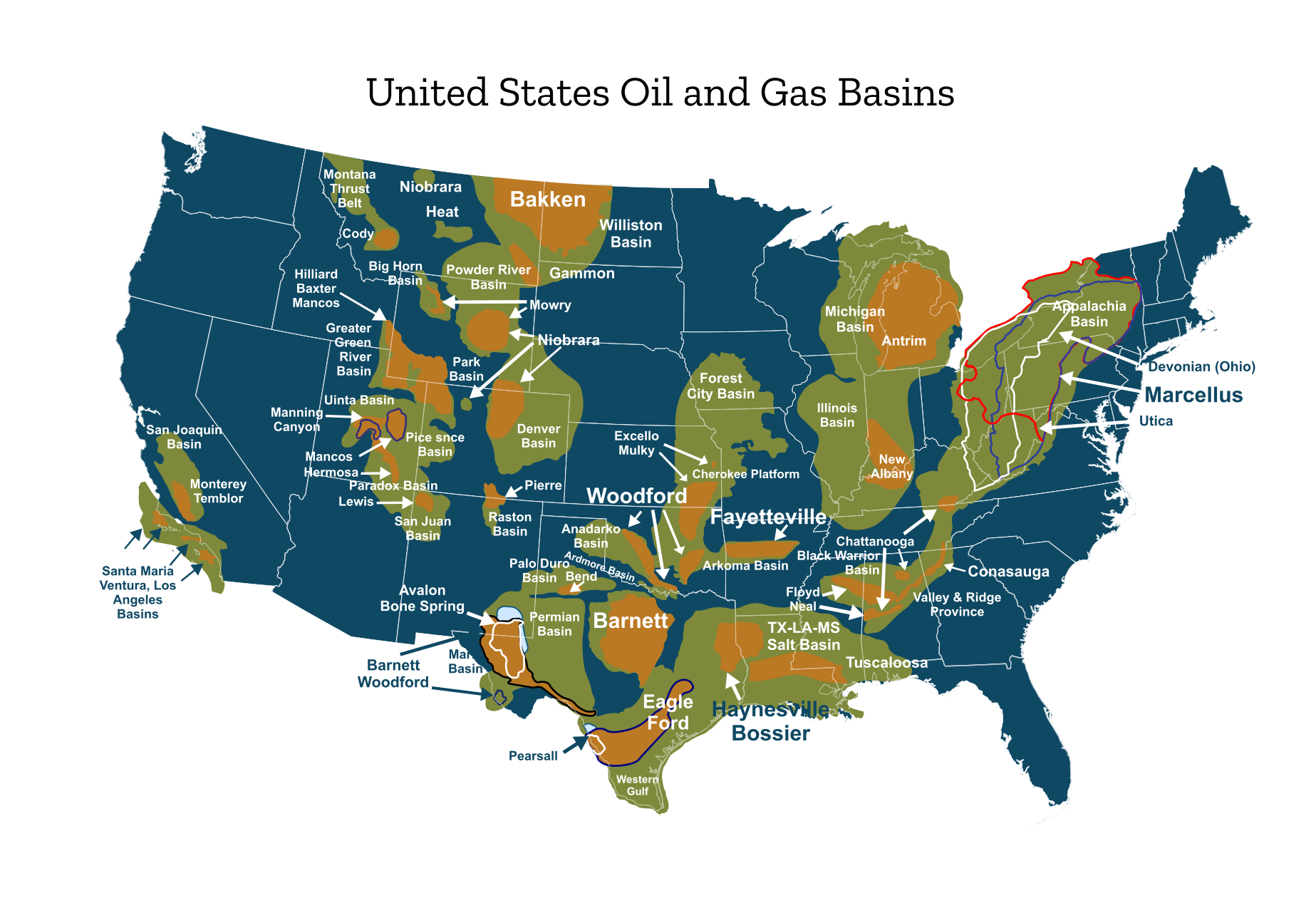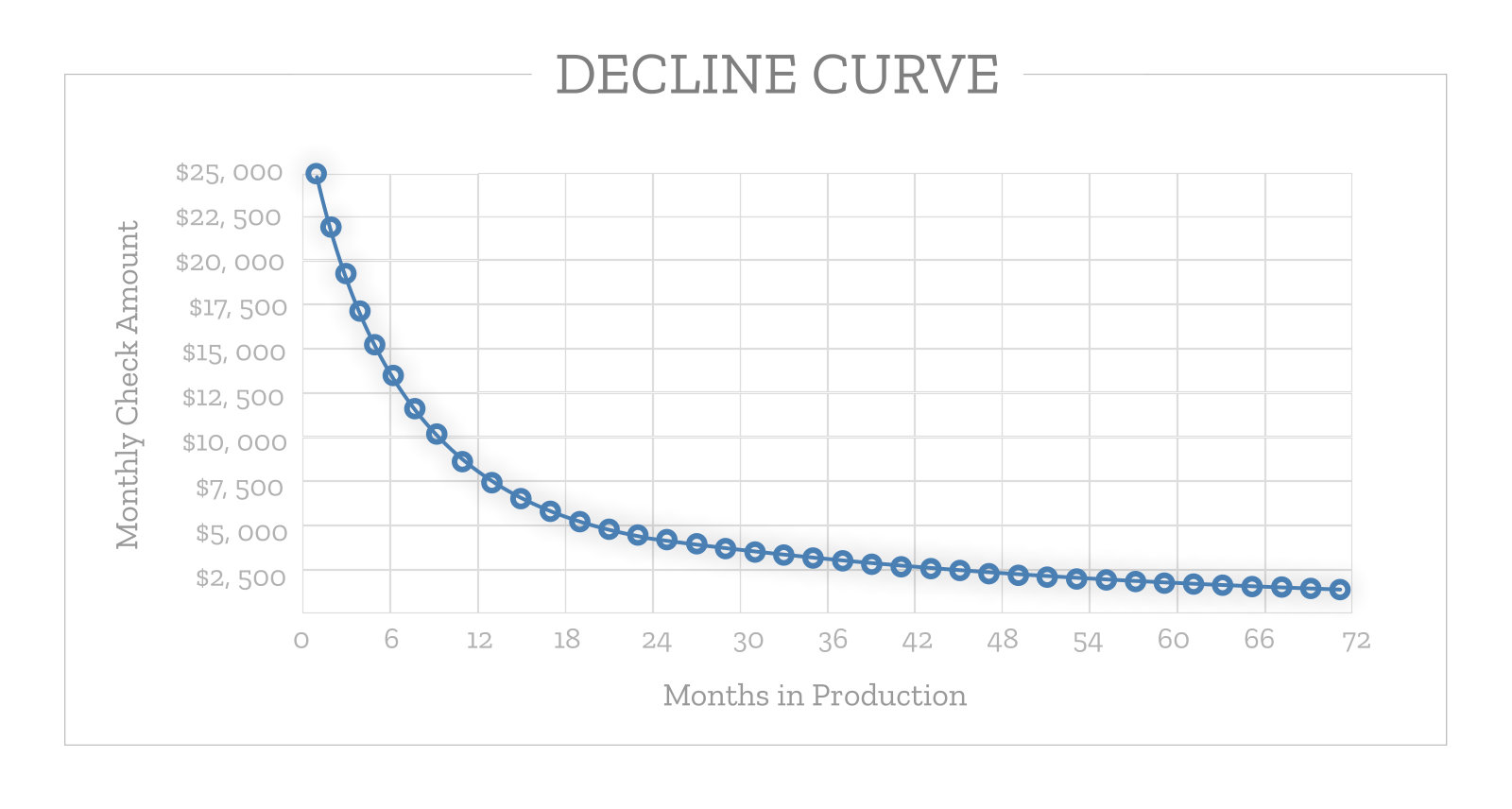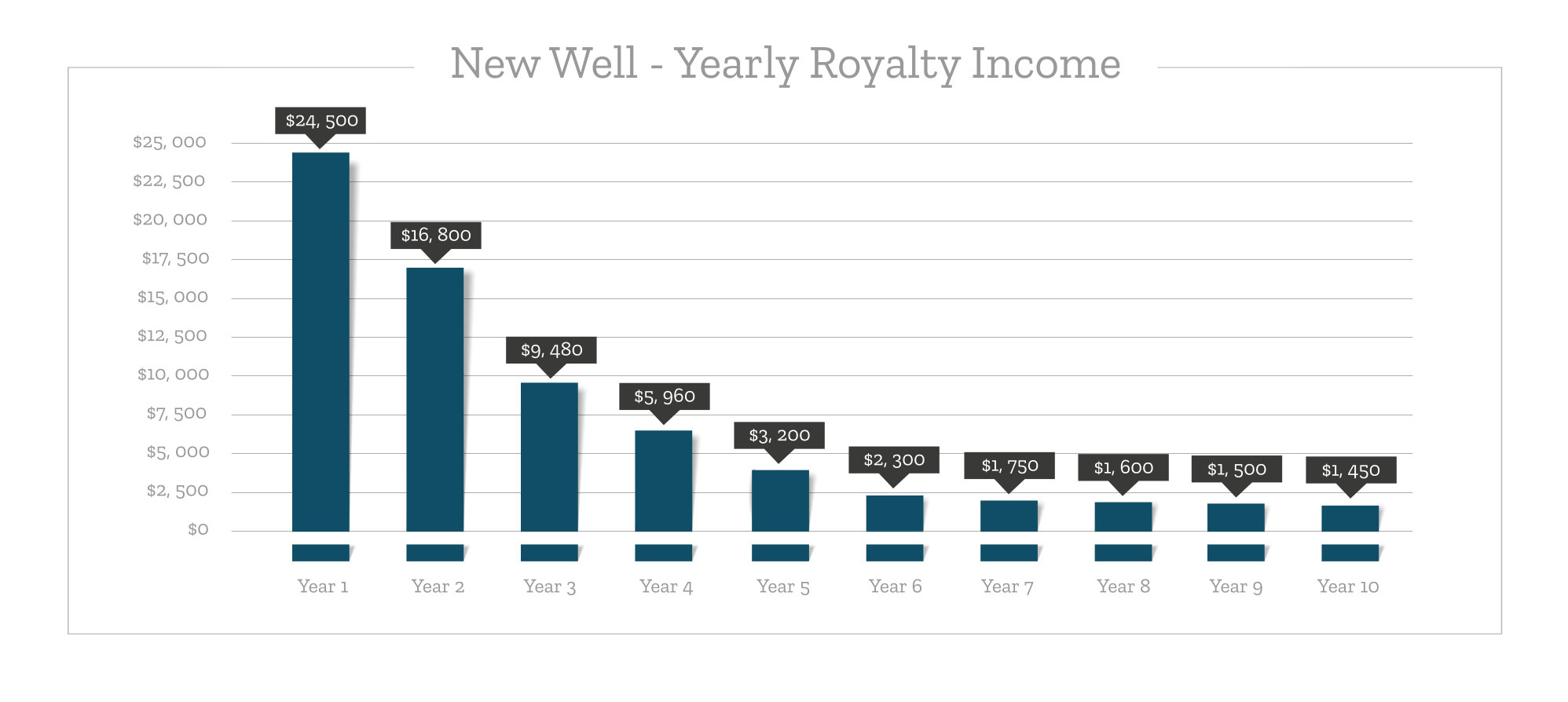Mineral Interest Types Explained
If you are new to mineral rights ownership understanding what you own is important. There are a lot of different types of mineral rights ownership. It can get complicated very quickly.
Before we explain the different mineral interest ownership types, it helps to know which type of ownership you have! If you are currently receiving royalty income, pull out your most recent check stub. Your check will either directly say what type ownership you have like example 1, or it will have an abbreviation for your ownership type like example 2.
Most operators will add a key to the bottom that tells you what the abbreviation stands for. Some operators will not put a key at the bottom. While there are common abbreviations, these can vary by operator.
If you have questions about what type of mineral interest you have please send us a check stub and we can help you out. Simply fill out the contact form at the bottom of this page or click the green button below for a free consultation. These forms will allow you to upload a copy of your latest check stub. Examples of check stubs can also be found in this post.
Example 1: Non-Participating Royalty Interest
Example 2: Royalty Interest
Types of Mineral Interest Ownership
As a mineral owner there are a few different types of mineral interest you can own. Mineral rights ownership is commonly abbreviated in the Oil and Gas industry. We have included the most common abbreviations with each definition.
Note: We are simplifying the mineral rights ownership types below to make it easier to understand. There are some exceptions and rules that we won’t cover here.
Here are the most common types of mineral rights ownership to understand:
Royalty Interest (RI): This is the most pure form of mineral rights ownership. You own all rights to the oil and gas underground without restriction of any kind. You have the right to lease the property, negotiate lease terms, collect lease bonus payments, and collect royalty income. You are not responsible for any drilling or completion related expenses, and little or no production related expenses will be deducted from your royalty checks as defined in your lease.
Working Interest (WI): A royalty interest owner may become working interest owner by choosing to participate in the oil and gas drilling alongside the operator. When a royalty owner chooses this option, they become responsible for their share of drilling, completion, and production related expenses. You could make more money as a working interest owner, however, there is substantially more risk. For example, if a dry hole is drilled you would still owe your share of the expenses and would never collect any income since the well never produced any oil and gas.
Non-Participating Royalty Interest (NPRI): A non-participating interest owner has the right to collect royalty income but does not have the right to lease the mineral rights, negotiate lease terms, or collect a lease bonus. While you have the right to collect royalty income you don’t get to negotiate the lease royalty rate, lease term, deductions, or collect the lease bonus paid by an operator when a lease is signed.
Executive Rights: The flip side to an NPRI ownership is executive rights. With executive rights you have the right to negotiate a lease, including the lease royalty rate, lease terms, etc. In addition, you have the right to collect any lease bonus paid for leasing the mineral rights. Note: This interest type would not be listed on a check stub because this type of ownership would not entitle you to receive royalty income.
Overriding Royalty Interest (ORRI): An ORRI interest is created at the time that a lease agreement is signed. This can be created in a few ways, but one way is when someone leases your property, then turns around and leases the property for a higher royalty percentage. For example, if you leased to John Smith Drilling for 20%, and then he turns around and leases the property to ABC Drilling for 25%, John Smith Drilling now has a 5% ORRI on your mineral rights (25% – 20% initial lease). You would still collect your 20% royalty as originally agreed, but John Smith gets a 5% royalty for his ORRI. Important: This ORRI only remains in affect if the lease is drilled on and for as long as the lease continues to be held by production. If a well is never drilled before the lease expires, John’s 5% ORRI will also expire and has no value. If a well is drilled, once that well stops producing and the original lease expires, the ORRI interest can also expire. If you own an ORRI, a mineral buyer must be cautious because the ORRI interest may eventually expire and have no value.
Mineral Classified: This type of ownership can only occur in Texas. If you have mineral classified ownership, the state of Texas gets 50% of all royalty income generated from the mineral rights. For example, if you are leased at a 25% royalty, you would only be entitled to get a 12.5% royalty because the state of Texas would get 12.5% as well. In addition, the mineral rights ownership and the land ownership cannot be severed. If you want to sell your classified mineral rights, you must sell the land with the mineral rights ownership. Generally speaking, you will know if you have mineral classified ownership. If you don’t know, you likely have one of the other types of ownership as this is a very uncommon type of mineral rights ownership.
Phases of Mineral Rights Ownership
In addition to the different types of mineral interests you may own, it’s important to understand the different phases of mineral rights ownership. You may own a royalty interest (RI), but that ownership could be in one of three phases.
The three phases of mineral rights ownership are:

Non-Producing Mineral Rights – Unleased
When an oil and gas company decides they want to drill in an area, they must lease the property. If you are not receiving a royalty check each month and you have not signed a lease agreement, you have non-producing unleased mineral rights. The value of non-producing unleased mineral rights is the most difficult to determine. The reason is that there is not a high probability of any drilling taking place soon. The property will first need to be leased and then drilled on which will easily take 5+ years.
Important note: In general, we do not list non-leased / non-producing properties at US Mineral Exchange. Typically the value of non-leased / non-producing acreage is in the range of $0 to $250/acre depending on the state and county. We do make rare exceptions for clients who have a substantial (250+ net mineral acres) amount of non-leased / non-producing acreage, have a recently expired lease, or have offers in excess of $50,000. Please contact us if you are unsure about what the potential value might be and we can point you in the right direction.
Non-Producing Mineral Rights – Leased
If you are not receiving a royalty check each month but you have signed a lease agreement that is still active, you own non-producing mineral rights that are currently leased. This is a good situation to be in because it means that an oil and gas company intends to drill on your property in the next 3 to 5 years. In addition, it means there will be demand from buyers are who are interested in purchasing your property. You have the flexibility to sell mineral rights now or wait and see if drilling takes place and you start receiving monthly royalty checks. While being leased means there is a reasonable chance drilling will take place in the next 3 to 5 years, it’s very possible that no drilling occurs.
Note: If you have not signed a lease in 5+ years, it is safe to assume you have non-leased / non-producing mineral rights.
Producing Mineral Rights
The easiest type of property to identify are producing mineral rights. You own producing mineral rights when the oil and gas company has already drilled on your property. Each month you receive a royalty check for your share of the oil and gas production. This royalty check is the key indicator that you own producing mineral rights. If you do not receive a royalty check each month (or every few months) then you have non-producing mineral rights.
The nice thing about producing mineral rights is that there is a high demand for them. When you sell producing mineral rights there will be a large number of people who make offers on your property. Check out our article about the value of royalties to learn more about what your producing mineral rights could be worth.
Important Mineral Ownership Terms
Entire books have been written about oil and gas terms. This is not an all encompassing oil and gas glossary. Instead, we are cherry picking the most important terms you need to understand as a mineral owner.
Mineral Rights/Royalties/Property: Oil and Gas mineral rights have a lot of different names within the industry. These names get thrown around loosely, but tend to all mean the same thing. Regardless of what type of mineral rights ownership you have or what phase of ownership you are in, your mineral rights could be referred to as minerals, mineral rights, royalties, property, or some combination of those words. Mineral rights are considered personal property. As such, frequently mineral rights ownership is referred to as “property”. This is confusing to many owners as they don’t own the surface (land). Even if you don’t own the surface your mineral rights are still property.
Lease Agreement: The lease agreement is a document that gives an oil and gas operator the right to extract your oil and gas. The lease agreement is the first step in the process before drilling can take place. You will be approached to lease your mineral rights. There will be specific terms in this lease agreement such as the lease royalty percentage, pugh clause, term of lease, etc that are very important. Once wells start producing oil and gas this lease determines what percentage of the revenue you get, what expenses may be deducted, etc.. A lease agreement remains in effect for as long as oil and gas is produced, which could be and often is, decades.
Royalty Percentage: The royalty percentage, also referred to as royalty rate, specified in your lease agreement determines what percentage of the production you get. The higher your royalty percentage, the more money you will receive from production. If a 12.5% lease would have meant $1,000/month income, a 25% lease would mean $2,000/month income. When selling mineral rights, a property leased at 25% will sell for substantially more than one leased at 12.5%.
Lease Bonus: When you sign a lease agreement, you are entitled to collect a lease bonus. This lease bonus compensates you for the time that an operator has to drill for oil and gas. When you sign the lease agreement, you will be paid once for signing. If the lease agreement is extended, you will be paid again for the extension. The lease bonus amount will be higher or lower depending on the royalty rate. For example, you may get $1,000/acre for a 25% royalty or $2,000/acre for a 12.5% royalty. By taking a higher up front payment you are getting a lower amount of royalty income in the future if they drill.
Lease Term: All leases will have a term in effect. Typically an oil and gas lease will be 3 years + 3 years or 5 Years + 5 years. As an example, when you sign the initial lease, it will be a for a period of 3 years. The operator has the option to add 3 more years to the lease if they pay another lease bonus. If the operator exercises the option to add 3 more years to the lease, this is called a lease extension. Another lease bonus payment must be made when the lease is extended. Typically this lease bonus is equal to the initial lease bonus amount for the first term. If no drilling takes place during the initial lease or the lease extension (if extended) then the operator no longer has a lease on the property and does not have the right to drill.
Top Lease: A top lease occurs when your mineral rights are currently leased. Another operator may wish to be first in line to have a lease on this ownership if the current lease expires. This operator may pay you for a top lease which automatically starts the moment the existing lease expires.
Surface Ownership: If you own the land along with your mineral rights, you have surface ownership. It’s less common to own both the land and the mineral rights. Most mineral owners do not have surface ownership, they only own mineral rights.
Right of Way: If you do own the surface / land, you may have heard the term right of way. Right of way is a payment made to you for damaging your land or creating some type of inconvenience. For example, a drilling rig may not be on your property, but they need to drive over your property to get to the location. The oil and gas company would make you a right of way payment for the damage they cause by creating the road through your property.
Oil and Gas Permit: An oil and gas permit must be filed with the state before drilling can take place. If a permit has been filed on your acreage, it means drilling could occur, but it does not necessarily mean it will. Drilling permits are frequently filed with the state when their is no intention to drill. Oil and gas operators file the permits because they take time. Having multiple permits filed allows them to have options when deciding when and where to drill. The last thing an oil and gas operator wants to do is wait on state approval for a drilling permit. They file these way ahead of time and only drill in a small percentage of the drilling permits granted.
Formations: There are typically many different layers underground. Think of a 7 layer cake. Each layer may represent different options such as more oil, more gas, less water, easier to frack, etc.. Each layer, or formation, is at a different depth.
Oil and Gas Basin: Throughout the United States there are a number of different basins. These basins are also referred to as “plays” sometimes. A basin or play defines a geographic area based on formations that can be reached. Here is a map of the different oil and gas basins in the United States:
Division Order: When and oil and gas operator drills a new well, ownership changes, or a number of other things occur, a division order will be sent to the mineral owner. The division order allows the operator to place you in to pay status and start paying you royalties. A division order is basically a fancy name for a document that describes your ownership and you sign saying that you agree you are the correct owner and your information on file is correct. If you do not sign your division order, you will not be paid royalties.
Royalty Check / Check Stub: Once an oil and gas operator drills, and the division order is signed, you will start getting royalty checks each month. Sometimes these royalty checks are sent via direct deposit. Each month a “Check stub” will be generated whether you receive one or not. This check stub that goes along with the royalty check is an accounting of the royalty income due to you. The check stub will show the wells you are being paid for, your interest, your ownership type, volume, oil and gas prices received for selling, and lots of other details related to the production. Note: This is a key piece of information when selling mineral rights.
Net Revenue Interest / Net Decimal Interest / Owner Interest: On your check stub, you will see a decimal listed that specifies your percentage of the total amount the well generated. Typically this decimal will look like (.00xxxxxx). This decimal interest is determined by the number of acres in the unit, your royalty rate, and some additional calculations. This NDI/NRI/OI listed on the check stub can be used to estimate how many net royalty acres or net mineral acres you own.
Drilling Unit / Spacing Unit / Pooled Acres: These words are all used interchangeably and generally mean the same thing. The unit size refers to how many acres were combined into a single block of acreage to drill on and extract oil and gas from. For example, you may have 10 net acres personally, but when they drill they will be drilling on a 640 acre spacing unit. Let’s say they drill a well that is not directly on your acreage, but is part of the 640 acre unit. You would still get your percentage of the proceeds from that well. You would be entitled to your 10/640 share of the production. The math is a lot more complicated than this, but this is a simple way to look at your ownership within a unit. Note: If you are in an 80 acre unit they may not have room to drill additional wells where a 640 acre unit would have space for 6+ wells. However, you would get a larger share of the production from that single well (10/80 vs 10/640).
Production Decline Curve: During the first few years after a well is drilled, the amount of oil and gas will dramatically decline. This natural decline is called a production decline curve. Different locations/basins/plays will have different decline curves. During the first 3 to 5 years of a new wells life the production will decline very rapidly. By the time a well hits years 5+, the large initial decline will level off. The well gradually produces less oil and gas over time but will be more consistent after 5+ years.
Pay Status: When you are receiving oil and gas royalty income from an operator, you are in “pay status.”
Suspense: When you are due oil and gas royalty income from an operator, but they can’t yet pay you for various reasons you are in “suspense” status. This means your oil and gas royalties are accruing in your name and being held by the operator until issues can be resolved and they can pay you.
Escheatment: If you are held in suspense status long enough, by law, the operator must escheat money to the state where the income was generated. Do a google search for “statewhereyouown escheatment search” and find the states website to check for escheatment funds. Then see if your name or any ancestor names show up. If the state is holding funds for you in escheatment, you may be entitled to oil and gas royalty income that you aren’t receiving.
Gross Mineral Acre vs Net Mineral Acre: A gross mineral acre is used to describe a particular section of land. A gross mineral acre refers to the acreage when it was originally described. For example, if your great grand father participated in the land run and got 120 acres, that would be 120 gross acres. After he passes away and the ownership is passed from generation to generation (typically being split multiple ways each time), you end up with net mineral acres. On a mineral deed, lease agreement, etc, the gross mineral acres are typically listed as they describe the tract. However, your ownership within that gross acreage is your “net” acre or the number of net mineral acres owned. You are paid based on how many net mineral acres you have not the gross acres. You cannot determine net acres owned based upon gross numbers without a check stub.
Net Mineral Acre vs Net Royalty Acre: Mineral buyers will sometimes make offers on either a net mineral acre or net royalty acre basis. A net mineral acre could be leased at any percentage. A net royalty acre assumes a 12.5% lease. For example, if you have 20 net mineral acres leased at 12.5%, you have 20 net mineral acres and 20 net royalty acres. However, if you have 20 net mineral acres leased at 25%, you have 20 net mineral acres and 40 net royalty acres (a 25% lease is double 12.5%, so you have double the net royalty acres). Your number of net mineral acres does not change, but the number of net royalty acres owned can change based upon your lease royalty rate. This is a way for mineral buyers to quickly compare two deals apples to apples based on the number of net royalty acres they are getting in the deal.
Purchase and Sale Agreement (PSA) / Letter of Intent (LOI): When you sell mineral rights you will sign a PSA or LOI. These documents have different names but both do the exact same thing. The PSA or LOI will specify the terms of the deal. It will list how much is to be paid, the legal description, closing terms, etc.. This document is extremely important for mineral owners. If you do not understand a PSA when selling mineral rights you run the risk of being taken advantage of.
Option Agreement: Some “mineral buyers” will have you sign an option agreement. The option agreement gives the buyer the option, but not the obligation, to purchase your mineral rights at a specific price for a specific period of time. Typically, an option agreement is 90 days. When you sign an option agreement to sell mineral rights the option hold will try and flip your minerals. They will get you to agree to a certain price and then find a real mineral buyer at a higher price so they can make a big profit.
Mineral Deed: A mineral deed is the document that is used to convey your mineral rights ownership to another party. Typically, a mineral buyer will prepare a new mineral deed for you to sign transferring the ownership to them. While mineral deeds are pretty standard, there are some major land mines built into some mineral deeds that you should be cautious about. Consult with US Mineral Exchange if you have been presented with a mineral deed to sell mineral rights.
Landman: If you believe you own mineral rights but you have no proof of ownership, you would hire a landman. A landman will go to the county clerk and pull records about land ownership. They will create a chain of title to prove any oil and gas mineral rights ownership you may have. If you need to hire a landman, check out Western Land Services or findalandman.com
Contact US Mineral Exchange:
If you have questions about your mineral rights, we’re here to help! We speak with mineral owners every day and we look forward to hearing from you. Please don’t hesitate to fill out the form below with any questions and our friendly team will respond quickly.
Popular Content
- Sell Mineral Rights
- Mineral Rights Value
- Calculate Value
- Market Value
- Mineral Rights Buyers
- Mineral Rights Appraisal
- Mineral Rights Brokers
- Should you Sell Mineral Rights
- Never Sell Mineral Rights
- 10 Helpful Tips
- Mineral Interest Types Explained
- Common Mistakes
- Mineral Rights & Taxes
- Medicaid & Mineral Rights
- Common Q&A

